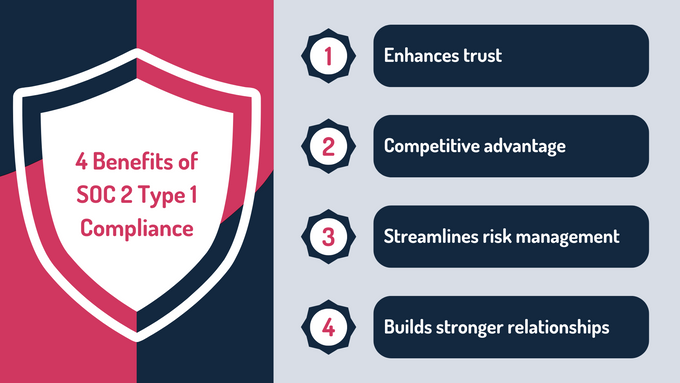How SOC 2 Type 1 Compliance Secures Partnerships & Investments
Discover how achieving SOC 2 Type 1 compliance enhances your organization's credibility, fosters trust with partners, and attracts potential investments by demonstrating robust data security practices.
Published April 5, 2025.

As modern businesses strive to ensure data security and build trust, SOC 2 compliance has become an important standard for demonstrating effective internal controls. This report reassures partners, investors, and clients that an organization is taking serious steps to protect sensitive data and manage operational risks efficiently, thereby reinforcing its commitment to safeguarding digital assets.
SOC 2 compliance not only validates a company's commitment to security standards but also enhances its competitive edge in the market. With a robust control environment, businesses can strengthen partnerships and foster long-term trust with stakeholders, setting themselves apart from competitors.
» Let the experts handle your SOC 2 Type 1 compliance with our startup and enterprise services
SOC 2 Type 1 vs. SOC 2 Type 2: What’s the Difference?
Before diving into the differences between SOC 2 Type 1 and Type 2, it's essential to understand what SOC 2 compliance entails.
SOC 2, established by the American Institute of CPAs (AICPA), focuses on ensuring that an organization has the necessary controls in place to protect sensitive data, particularly when it comes to service organizations handling customer information.
SOC 2 covers five key areas:
- Security
- Availability
- Processing integrity
- Confidentiality
- Privacy
SOC 2 Type 1
SOC 2 Type 1 evaluates the design of internal controls at a specific point in time, focusing on whether the necessary processes are in place.
SOC 2 Type 2
SOC 2 Type 2 goes beyond design evaluation and tests the operational effectiveness of those controls over a specified period, typically ranging from 3 to 12 months.
» Learn more about SOC 2
4 Benefits of SOC 2 Type 1 Compliance
1. Enhances Trust and Credibility Achieving
SOC 2 Type 1 compliance showcases a company's commitment to maintaining high standards of security and integrity.
This compliance provides customers, partners, and investors with confidence that the organization has a solid control environment in place. Moreover, it assures stakeholders that you prioritize security and are capable of safeguarding sensitive data, which ultimately enhances trust and credibility in the marketplace.
» Here's how to create a secure development lifecycle
2. Competitive Advantage
In industries where data security is paramount, such as healthcare, finance, and technology, SOC 2 compliance gives businesses a competitive edge.
Many clients and partners now require proof of security standards before engaging with a service provider. With this report, organizations can differentiate themselves from competitors that lack proper compliance, making it easier to secure new deals and expand business opportunities.
3. Streamlines Risk Management
SOC 2 compliance involves a thorough risk assessment of an organization's internal controls, allowing businesses to identify potential risks earlier rather than later.
Addressing these risks and implementing proper controls can help mitigate potential threats to data integrity and system availability. This approach to risk management helps prevent operational disruptions and reduces the likelihood of costly security incidents.
» Check out these 6 tips before hiring a risk assessment service provider
4. Builds Stronger Relationships With Investors
SOC 2 type 1 compliance helps businesses respond to client inquiries quickly, providing immediate proof of effective internal controls.
If businesses can't afford to wait months for a Type 2 report, they can present the Type 1 report along with a letter of engagement, promising a forthcoming Type 2 in a few months. This proactive approach reassures clients, saves time, and addresses security concerns, making it easier to secure partnerships and move forward.
» Read more about the merits of adopting SOC 2
Timeline for Achieving SOC 2 Type 1 Compliance
Achieving SOC 2 Type 1 compliance involves a structured approach divided into two key phases: preparation and the audit itself. Understanding these phases is crucial for organizations aiming to establish the necessary controls to protect sensitive data.
Preparation Phase
The preparation phase, where businesses implement the necessary controls, usually lasts 3 to 6 months, depending on the complexity of the organization and its ability to meet the requirements. Of course, leveraging technologies like compliance automation platforms can expedite this process.
» Wondering about automation? See if AI is fundamental to the future of cybersecurity
Audit Phase
Once the preparation phase is complete, the audit typically takes only a few days, with the final report issued within approximately two weeks. The timeline for completion can vary depending on factors like the complexity of the company's internal systems and its readiness for the audit.
Tip: After achieving SOC 2 Type 1 compliance, the best practice to maintain the confidence of partners and investors is to move towards SOC 2 Type 2 compliance. This way you can demonstrate that you are not only meeting initial standards but are also continuously improving your security posture to meet new challenges.
» Discover the disasters you can avoid by tackling cybersecurity on time
SOC 2 Adoption Trends and Communication Strategies
Compliance automation tools are becoming increasingly popular. These tools provide organizations with streamlined platforms to manage their SOC 2 efforts, centralizing tasks and tracking compliance progress to help businesses achieve and maintain SOC 2 standards efficiently.
When communicating SOC 2 compliance to potential clients, organizations often share a SOC 2 Type 3 report. This high-level summary presents key compliance findings without revealing sensitive operational data, helping businesses maintain confidentiality while demonstrating their commitment to security.
Overcoming Challenges in SOC 2 Type 1 Compliance
SOC 2 Type 1 compliance can be daunting not because of any single requirement, but rather due to the broad scope of the process. Let's take a look at the most common challenges when achieving SOC 2 compliance:
- Prioritizing controls: Many organizations struggle with knowing which controls to focus on. Addressing high-impact areas first, such as data security and risk management, can simplify the process.
- Complexity of implementation: The sheer number of processes to set up can be overwhelming. Breaking the process into smaller, manageable tasks ensures progress without getting bogged down.
- Lack of internal expertise: Organizations often lack the internal knowledge required for compliance. Bringing in outside experts or training staff can help overcome this hurdle.
- Time constraints: With tight deadlines, getting everything ready can feel impossible. Starting early and using automation tools can save significant time and reduce pressure.
» Simplify SOC 2 Type 1 compliance with our expert guidance
Key Factors in Choosing a SOC 2 Auditor
When going for SOC 2 compliance, the auditor plays an important role by conducting a thorough evaluation of the organization's internal controls and issuing a detailed report. The report must reflect the findings, ensuring that all security measures have been properly implemented and addressed.
Let's take a look at the four key factors that you should consider:
- Expertise in security: An auditor with a deep understanding of security practices is crucial. Their expertise ensures that the audit is comprehensive, highlighting all necessary controls and preventing the issuance of incomplete or vague reports.
- Reputation and track record: Look for auditors with a strong reputation for issuing reliable, client-accepted SOC reports. Their track record can indicate their ability to provide quality audits.
- Communication and detail: Clear, detailed reports are essential, ensuring clients don't need follow-up questions and auditors provide precise documentation.
» Here are some things to know before hiring a risk assessment provider
How GRSee Helps Streamline SOC 2 Type 1 Compliance
At GRSee, we start with a comprehensive gap analysis, pinpointing where your organization falls short in meeting SOC 2 standards, whether you're going for Type 1 or Type 2 compliance. Our team brings extensive experience, assigning dedicated consultants and project managers to ensure efficient project movement before the official CPA audit. We also offer ongoing support to address any emerging issues quickly, minimizing delays and optimizing readiness.
» Ready to reach SOC 2 compliance? Contact us





